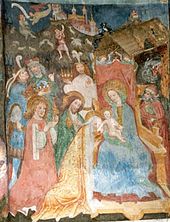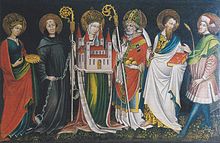Villach School
A workshop for painting and carving from the 15th / 16th centuries, located in Villach (Southern Carinthia), is established as the Villach School . Century, the artistically designed works, mainly sacred art ( winged altar , fresco , panel painting ) produced in the late Gothic style.
presentation
The most important representatives of the Villach School with its late Gothic painting and carving art were master Friedrich von Villach , his son Johannes von Villach and Friedrich's presumed pupil Thomas von Villach . Little is known of Master Friedrich; some of Thomas von Villach's life and work have come down to us. The painting and carving of the Villach School had more in common stylistically with Friuli , Carniola , the German South Tyrol and the Dutch School than with the Danube School . Thomas von Villach in particular received artistic impulses for his own work through his involvement with Italian and later with Dutch art. Detailed imitation of nature, spatial illusion, brilliant colors, stringent compositions as well as moving facial expressions and gestures were the hallmarks of Flemish painting, which was also reflected in the Villach school. Thomas was particularly characterized by very fine and detailed work. He worked in Villach from around 1455 and there is evidence that he still lived in 1520.
Art venues
Certificates from the Villach School can be found in numerous churches in Carinthia , for example in
- Feistritz an der Drau , Maria am Bichl church: it houses important wall paintings (around 1440) that are assigned to the workshop of Friedrich von Villach. On the south wall in the upper zone there is Christ on the Mount of Olives, below Christ before Pilate, the undressing and flagellation, including the crucifixion and lamentation of Christ.
- Bad Kleinkirchheim , St. Katharina in the bath : in the church there is a winged altar from the younger Villach school, which was donated by the Millstatt Knights of St. George around 1520.
- Glanegg , St. Gandolf Parish Church : it contains frescoes that are attributed to Friedrich von Villach (around 1440), including The Adoration of the Magi .
- Maria Elend, pilgrimage church Maria Elend : the winged altar (around 1515) was created by artists from the Villach School under the aegis of Lukas Tausmann . It is considered to be one of the most beautiful late Gothic winged altars in Carinthia.
- Maria Gail , Maria Gail pilgrimage church : the winged altar (around 1515) is considered a masterpiece of the Villach school. Its central motif is the coronation of Mary.
- Maria Saal , pilgrimage church Maria Saal : the so-called Arndorfer winged altar (1520–1522) was made by the so-called Younger Villach carving workshop. Its central motif is the coronation of Mary. The predella shows a pietá.
literature
- Franz Kollreider: Late Gothic carved altars and individual sculptures from the Villach School in East Tyrol. In: News from Alt-Villach. Vol. 2, 1965, ISSN 0258-8382 , pp. 139-156.
- Wilhelm Neumann: The most important painter of the Carinthian late Gothic, Thomas Artula von Villach. In: News from Alt-Villach. Vol. 20, 1983, pp. 59-98.
- Achim Simon: Austrian panel painting of the late Gothic. Reimer, Berlin 2002, ISBN 3-496-01256-0 .
Web links
Individual evidence
- ↑ Johannes von Villach. Retrieved May 26, 2015 .




